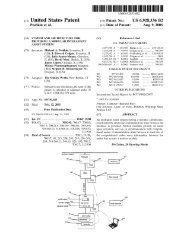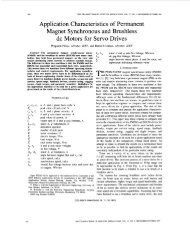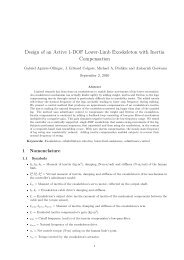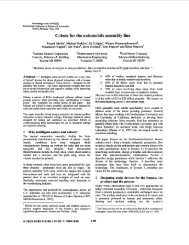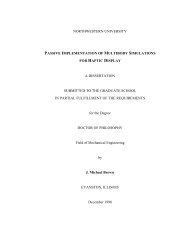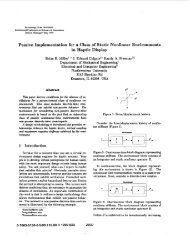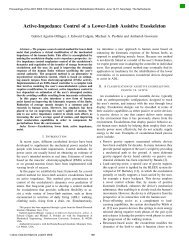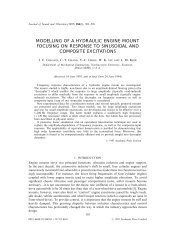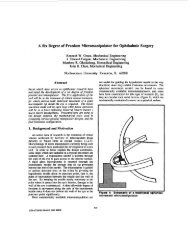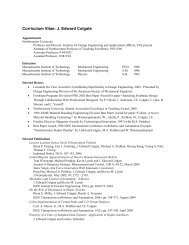The Web As A Model Technology in Freshman Design - Colgate
The Web As A Model Technology in Freshman Design - Colgate
The Web As A Model Technology in Freshman Design - Colgate
Create successful ePaper yourself
Turn your PDF publications into a flip-book with our unique Google optimized e-Paper software.
Session 3353<br />
<strong>The</strong> <strong>Web</strong> as a <strong>Model</strong> <strong>Technology</strong> <strong>in</strong> <strong>Freshman</strong> <strong>Design</strong><br />
J. Anderson, J. E. <strong>Colgate</strong>, P. Hirsch, D. Kelso, B. Shwom, C. Yarnoff<br />
Northwestern University<br />
Abstract<br />
<strong>The</strong> challenge of teach<strong>in</strong>g design to freshmen is to f<strong>in</strong>d projects and technologies that suit<br />
their level of proficiency while allow<strong>in</strong>g them to experience the design process and<br />
prepare for upper level courses. In the first quarter of a two-quarter freshman course <strong>in</strong><br />
design and communication, students work on web site projects for campus clients. <strong>Web</strong><br />
technology is an effective tool for this purpose because it is widely available, <strong>in</strong>expensive,<br />
timely, easily learned (at a basic level) and well suited to teach<strong>in</strong>g the processes of design<br />
and communication. <strong>As</strong> they engage <strong>in</strong> reverse eng<strong>in</strong>eer<strong>in</strong>g, generat<strong>in</strong>g alternatives,<br />
<strong>in</strong>terview<strong>in</strong>g clients and users, etc., students learn techniques that they apply <strong>in</strong> the<br />
second quarter to other k<strong>in</strong>ds of projects.<br />
Introduction<br />
Despite the grow<strong>in</strong>g trend <strong>in</strong> eng<strong>in</strong>eer<strong>in</strong>g education to have more students study design at<br />
an earlier po<strong>in</strong>t <strong>in</strong> their education, 1-4 many eng<strong>in</strong>eer<strong>in</strong>g faculty question whether design is<br />
an appropriate activity for freshmen. Traditionally, “eng<strong>in</strong>eer<strong>in</strong>g design” has been an<br />
activity for seniors, who have the doma<strong>in</strong>-specific knowledge required to solve detailed<br />
technical problems. <strong>Design</strong> is taught <strong>in</strong> the capstone courses <strong>in</strong> their majors and is<br />
expected to culm<strong>in</strong>ate <strong>in</strong> a prototype with detailed plans, specifications, and calculations.<br />
<strong>The</strong>re are, however, many good arguments for teach<strong>in</strong>g design to freshmen and<br />
sophomores, especially s<strong>in</strong>ce detailed design is only one aspect of the design process.<br />
<strong>Design</strong> <strong>in</strong>volves general activities that freshmen can learn, such as gather<strong>in</strong>g <strong>in</strong>formation,<br />
generat<strong>in</strong>g alternatives, obta<strong>in</strong><strong>in</strong>g feedback, balanc<strong>in</strong>g compet<strong>in</strong>g requirements, and mak<strong>in</strong>g<br />
decisions. Moreover, <strong>in</strong>troductory design courses help students develop the<br />
competencies they need throughout their education and <strong>in</strong> <strong>in</strong>dustry–such as the ability to<br />
work <strong>in</strong> teams and to communicate effectively with clients, customers, and<br />
supervisors—and generate the excitement and motivation that theoretical courses too<br />
often lack. 5<br />
<strong>The</strong> challenge is to f<strong>in</strong>d projects that are with<strong>in</strong> a freshman’s technical capabilities, and<br />
that allow freshmen to experience the full richness of the design process and prepare to do<br />
doma<strong>in</strong>-specific projects <strong>in</strong> upper-level courses. At Northwestern, our answer to this<br />
challenge is to have students design web sites. 6 We have found that the World Wide <strong>Web</strong><br />
(which we will refer to simply as “the web”) is an effective technology for teach<strong>in</strong>g design<br />
because it is (1) convenient, (2) available, (3) well suited to teach<strong>in</strong>g the process of design,<br />
and (4) excellent for teach<strong>in</strong>g communication, a competency essential to design and to our<br />
students’ general professional and <strong>in</strong>tellectual development.
Background: NU’s freshman design course<br />
Our two-quarter freshmen course <strong>in</strong> design, Eng<strong>in</strong>eer<strong>in</strong>g <strong>Design</strong> and Communication or<br />
EDC, is a partnership between the Eng<strong>in</strong>eer<strong>in</strong>g School and the Writ<strong>in</strong>g Program at<br />
Northwestern. It is a collaboratively-taught course that is project-based, team-based, and<br />
equally focused on design and communication. By next year, the fourth year of our scaleup,<br />
EDC will be a required course for all 380 eng<strong>in</strong>eer<strong>in</strong>g freshmen at Northwestern,<br />
satisfy<strong>in</strong>g both their design requirement and their writ<strong>in</strong>g requirement. <strong>The</strong> goals of EDC<br />
are to:<br />
• <strong>in</strong>troduce freshman to the creative solv<strong>in</strong>g of complex problems<br />
• nurture student’s enthusiasm for eng<strong>in</strong>eer<strong>in</strong>g<br />
• complement the more analytical courses that are part of the first-year<br />
curriculum<br />
• improve students’ abilities <strong>in</strong> written, oral, graphical, and <strong>in</strong>terpersonal<br />
communication<br />
• form a foundation for a new “culture of design” at the eng<strong>in</strong>eer<strong>in</strong>g school<br />
In EDC, students attend one weekly lecture on design and two 16-person sections, teamtaught<br />
by faculty from eng<strong>in</strong>eer<strong>in</strong>g and writ<strong>in</strong>g. For most of the first quarter of EDC,<br />
four-person student teams design web sites for real clients that address real campus and<br />
community needs. <strong>The</strong>se projects <strong>in</strong>troduce students to the different stages of design,<br />
stress a user-centered approach, <strong>in</strong>volve a number of analytical tools and project<br />
management techniques, and culm<strong>in</strong>ate <strong>in</strong> three deliverables for clients and faculty: a<br />
mock-up or prototype of a web site, a written report, and an oral presentation.<br />
In the second quarter of EDC, students apply what they’ve learned from the web<br />
projects to new projects from a variety of discipl<strong>in</strong>es. Aga<strong>in</strong> work<strong>in</strong>g for local clients and<br />
supervised by a pair of faculty from eng<strong>in</strong>eer<strong>in</strong>g and communication, teams tackle such<br />
projects as a new cover for rollerblades, an enhanced pager system for volunteer firemen,<br />
a wheelchair for long-distance recreational use, a new storage system for a nearby<br />
elementary school, and an improved sound system for one of the university conference<br />
rooms.<br />
<strong>The</strong> first quarter of EDC: web design projects<br />
<strong>The</strong> w<strong>in</strong>ter quarter web design projects are <strong>in</strong>tended to give students a susta<strong>in</strong>ed, handson<br />
experience <strong>in</strong> design process. Toward that end, the quarter is divided <strong>in</strong>to three<br />
sections (see Table 1). Dur<strong>in</strong>g the first section (weeks 1-4), the teams work on<br />
understand<strong>in</strong>g the problem they face and develop<strong>in</strong>g several alternative design concepts.<br />
In past years, for example, students have been asked to design a web-based alternative to<br />
Northwestern’s course evaluation system, an on-l<strong>in</strong>e registration system for <strong>in</strong>tramural<br />
sports, an on-l<strong>in</strong>e lottery for campus hous<strong>in</strong>g, and web-based support for Northwestern’s<br />
new Human Resources software package. <strong>The</strong> students’ first step is problem def<strong>in</strong>ition.
<strong>The</strong>y bra<strong>in</strong>storm, conduct research, and use tools such as objectives trees (Figure 1) and<br />
morphological charts (Figure 2) to explore the design space and beg<strong>in</strong> generat<strong>in</strong>g<br />
alternatives. Dur<strong>in</strong>g the second section (weeks 5-7), the teams present their ideas to<br />
different audiences for critique. For example, at a design review for a project <strong>in</strong>volv<strong>in</strong>g<br />
on-l<strong>in</strong>e registration at the eng<strong>in</strong>eer<strong>in</strong>g school, one team presented their ideas to class<br />
members, <strong>in</strong>structors from several sections of EDC, and the Tech registrar. In the third<br />
phase (weeks 8-10), the teams conduct more user surveys and develop f<strong>in</strong>al designs.<br />
<strong>The</strong>se are presented orally to the clients <strong>in</strong> week 11. Clients also receive an extensive<br />
written report.<br />
All of the web projects focus on conceptual design. While students may produce a fully<br />
function<strong>in</strong>g web site for their client (at least for smaller-scale projects), they are not<br />
required to do so. Rather, the teams must produce mockups of their design alternatives<br />
for the early design reviews, and a mockup or prototype of their design for the f<strong>in</strong>al<br />
review and presentation. For a simple but effective mockup, a team may present their<br />
design with flipcharts and storyboards, PowerPo<strong>in</strong>t slides, or a simple series of HTML<br />
pages. For prototypes, the teams construct web sites that present most of the features of<br />
the team’s design—enough to conv<strong>in</strong>ce a critical audience that the design is valid—but<br />
with the more complex functions (such as form process<strong>in</strong>g, database queries, etc.)<br />
simulated rather than fully implemented. <strong>The</strong> emphasis is on present<strong>in</strong>g a bluepr<strong>in</strong>t to<br />
the client of what the team believes the client should do, not on build<strong>in</strong>g the whole<br />
product.
Week and topic: What the teams will do: Major assignments:<br />
1 Introduction Learn bra<strong>in</strong>storm<strong>in</strong>g and <strong>in</strong>structionwrit<strong>in</strong>g<br />
through a hands-on exercise.<br />
2 Def<strong>in</strong><strong>in</strong>g Problems Receive project assignment, schedule<br />
first meet<strong>in</strong>g with client, beg<strong>in</strong><br />
bra<strong>in</strong>storm<strong>in</strong>g user needs and<br />
eng<strong>in</strong>eer<strong>in</strong>g requirements.<br />
3 Gather<strong>in</strong>g Information F<strong>in</strong>d and reverse-eng<strong>in</strong>eer other web<br />
sites, prepare to <strong>in</strong>terview experts,<br />
gather background <strong>in</strong>formation on<br />
their project and client.<br />
4 Generat<strong>in</strong>g Alternatives Cont<strong>in</strong>ue to gather <strong>in</strong>formation,<br />
develop first solution-<strong>in</strong>dependent<br />
description of design ideas.<br />
5 Writ<strong>in</strong>g as a <strong>Design</strong> Process Write a draft of a progress report for<br />
<strong>in</strong>structors, receive feedback, prepare<br />
to model several design ideas.<br />
(Individual weekly software<br />
labs cover<strong>in</strong>g basic HTML<br />
and other topics are due <strong>in</strong><br />
weeks 2-10.)<br />
<strong>Design</strong> Specification,<br />
Release 1.0<br />
Prelim<strong>in</strong>ary <strong>Design</strong><br />
Proposal Draft<br />
6 Survey<strong>in</strong>g User Needs Revise the progress report, prepare a<br />
mockup of their design ideas for a<br />
review.<br />
7 Conduct<strong>in</strong>g a <strong>Design</strong> Review:<br />
1<br />
Present design ideas to users and<br />
gather mean<strong>in</strong>gful feedback through<br />
<strong>in</strong>terviews, surveys, and user test<strong>in</strong>g.<br />
Prelim<strong>in</strong>ary <strong>Design</strong><br />
Proposal<br />
(<strong>in</strong>cludes <strong>Design</strong><br />
Specification, Release 2.0;<br />
mockup of design)<br />
Survey Draft<br />
8 Build<strong>in</strong>g Consensus and<br />
Mak<strong>in</strong>g Decisions<br />
9 Conduct<strong>in</strong>g a <strong>Design</strong> Review:<br />
2<br />
Develop criteria for evaluat<strong>in</strong>g design<br />
ideas, beg<strong>in</strong> to develop a composite<br />
design.<br />
Present the composite design for<br />
further critique, write draft of f<strong>in</strong>al<br />
proposal. and get feedback from<br />
<strong>in</strong>structors.<br />
10 Persuad<strong>in</strong>g Revise f<strong>in</strong>al proposal; beg<strong>in</strong> draft<strong>in</strong>g<br />
oral presentation to client.<br />
<strong>Design</strong> Specification,<br />
Release 3.0<br />
<strong>Design</strong> Proposal Draft<br />
F<strong>in</strong>al <strong>Design</strong> Proposal<br />
(<strong>in</strong>cludes <strong>Design</strong><br />
Specification, Release 4.0;<br />
f<strong>in</strong>al prototype of design)<br />
11 F<strong>in</strong>al Presentation and<br />
<strong>Design</strong> Review 3<br />
Develop f<strong>in</strong>al prototype; present<br />
design to client for review<br />
F<strong>in</strong>al Presentation and<br />
<strong>Design</strong> Review<br />
Table 1. EDC web project outl<strong>in</strong>e.<br />
A week-by-week breakdown of activities for the EDC web-design project.
make sure somebody<br />
changes it<br />
keep it up to date<br />
don't put chang<strong>in</strong>g <strong>in</strong>fo on<br />
front page<br />
make it easy to change<br />
represent<br />
NU well <strong>in</strong><br />
eng<strong>in</strong>eer<strong>in</strong>g<br />
community<br />
make it appear<br />
technologically<br />
advanced<br />
make page<br />
consistent look<strong>in</strong>g<br />
make use of up to date<br />
stuff<br />
use similar font<br />
use similar colors<br />
Eng<strong>in</strong>eer<strong>in</strong>g<br />
First<br />
Objectives<br />
make it<br />
easy for<br />
professors<br />
to use<br />
provide <strong>in</strong>fo<br />
current<br />
students<br />
want/need<br />
make it easy to<br />
update<br />
teach them how it<br />
works<br />
make <strong>in</strong>fo easy to<br />
f<strong>in</strong>d<br />
keep it current<br />
use same page layout for<br />
each page<br />
provide multiple paths<br />
make logical structure<br />
make it easy to update<br />
sell program<br />
to<br />
prospective<br />
students<br />
provide them <strong>in</strong>fo<br />
they are look<strong>in</strong>g for<br />
provide access to contact<br />
people for answers<br />
use images<br />
write text on page<br />
give appearance of<br />
be<strong>in</strong>g fun<br />
use catchy phrases<br />
use images of students<br />
hav<strong>in</strong>g fun<br />
Figure 1. Objectives tree from Eng<strong>in</strong>eer<strong>in</strong>g First web site proposal.<br />
EDC WQ 98 M. Powers, S. VanSwam, T. Worsnopp, and W. Wu.<br />
(Eng<strong>in</strong>eer<strong>in</strong>g First is Northwestern’s new first year eng<strong>in</strong>eer<strong>in</strong>g curriculum. <strong>The</strong> team’s<br />
project was to design a web site that provided course <strong>in</strong>formation and other services to<br />
students and faculty <strong>in</strong> the program.)
Attribute<br />
Alternatives<br />
Page Layout Frames Vertical strip Uniform page Frames option<br />
What’s New? Sort by dates Sort by projects Sort by subjects<br />
L<strong>in</strong>ks to Site From other sites From search From other media<br />
eng<strong>in</strong>es<br />
SRG & ACT<br />
Separation<br />
Homogeneous<br />
layout<br />
Heterogeneous<br />
layout<br />
Employ colors Warm color Cold color Comb<strong>in</strong>ation<br />
colors<br />
Black & white<br />
Use of logo On background In header In fixed frame On title page<br />
Leave default<br />
MTL<br />
geographic<br />
location<br />
Contact<br />
Information<br />
Image map<br />
Central page<br />
Written<br />
directions<br />
With biography<br />
<strong>in</strong>formation<br />
L<strong>in</strong>k to travel site<br />
Phone number<br />
and email<br />
directories<br />
Interactive map<br />
Forms based<br />
email<br />
Screen 640 x 480 800 x 600<br />
resolution<br />
L<strong>in</strong>ks to other<br />
sites<br />
Central page Separate <strong>in</strong>to<br />
SRG and ACT<br />
Separate by type Disperse<br />
through site<br />
Graphics Thumbnails L<strong>in</strong>ked graphics Dynamic graphics With text<br />
Figure 2. Morphological chart show<strong>in</strong>g design decisions.<br />
Materials Technologies Lab web site project<br />
WQ 98 EDC S. Campbell, F. Mills, P. She<strong>in</strong>, J. Starzyk.<br />
<strong>As</strong> students focus on web design <strong>in</strong> the first quarter of EDC, they are also be<strong>in</strong>g shown<br />
how the design steps and tools can be applied to other problems. For example, <strong>in</strong> the<br />
lectures where students are <strong>in</strong>troduced to bra<strong>in</strong>storm<strong>in</strong>g and reverse eng<strong>in</strong>eer<strong>in</strong>g, they have<br />
a chance to th<strong>in</strong>k about dr<strong>in</strong>k-holders that can fit onto desk tops and about book bags that<br />
can be dropped from great heights while still protect<strong>in</strong>g their contents. Students learn<br />
about f<strong>in</strong>d<strong>in</strong>g web <strong>in</strong>formation on the <strong>Web</strong> itself, but they also watch a video clip of an<br />
<strong>in</strong>terview with an expert <strong>in</strong> bicycle manufactur<strong>in</strong>g. All of this is to rem<strong>in</strong>d students that<br />
our focus is not web design, but the eng<strong>in</strong>eer<strong>in</strong>g design process. Later <strong>in</strong> the course,<br />
<strong>in</strong>stead of <strong>in</strong>terview<strong>in</strong>g webmasters about the technical details of search eng<strong>in</strong>es or webbased<br />
survey forms, students may be talk<strong>in</strong>g to electrical eng<strong>in</strong>eer<strong>in</strong>g faculty about how to<br />
use an oscilloscope; <strong>in</strong>stead of build<strong>in</strong>g a web site <strong>in</strong> their room, they may be <strong>in</strong> the<br />
<strong>Design</strong> Studio’s mach<strong>in</strong>e shop build<strong>in</strong>g a plexiglass toy for a disabled child.
Advantages of us<strong>in</strong>g the web as a technology for teach<strong>in</strong>g design<br />
Initially we turned to web sites as projects for EDC because HTML and the other<br />
components of web- based design are simple enough to be accessible to first time<br />
designers, but complex enough to be <strong>in</strong>terest<strong>in</strong>g. Here was an abundant technology that,<br />
at our very “wired” campus, students would be able to study and use <strong>in</strong> their dorm<br />
rooms. For little or no expense, we thought, they could have <strong>in</strong> effect, their own<br />
mach<strong>in</strong>es for rapid-prototyp<strong>in</strong>g. Now, with three years of h<strong>in</strong>dsight, we realize that we<br />
picked a technology that offers many advantages, particularly convenience (which<br />
exceeded our expectations), availability of projects, suitability for teach<strong>in</strong>g design process,<br />
and appropriateness for teach<strong>in</strong>g communication.<br />
<strong>Web</strong> projects are convenient<br />
<strong>Web</strong> technology is even more practical and convenient than we orig<strong>in</strong>ally imag<strong>in</strong>ed. S<strong>in</strong>ce<br />
all eng<strong>in</strong>eer<strong>in</strong>g students need a basic understand<strong>in</strong>g of computer technology, regardless of<br />
their major, many come to school with sophisticated web skills, and others can quickly<br />
learn the necessary technology. We teach the basics of HTML through required,<br />
<strong>in</strong>dependent tutorials that provide a good basic understand<strong>in</strong>g of the different parts of a<br />
web site and how they function. For more advanced work, students can get help from the<br />
“EDC student consultants,” upperclassmen <strong>in</strong> eng<strong>in</strong>eer<strong>in</strong>g who can teach students such<br />
tools as JavaScript and Perl.<br />
Just as web technology is ubiquitous and free for the students (the software for build<strong>in</strong>g<br />
and view<strong>in</strong>g web sites is available for them to download or use <strong>in</strong> the public labs), so too<br />
it’s free and readily available for faculty—particularly a cross-school, multi-discipl<strong>in</strong>ary<br />
faculty who lack doma<strong>in</strong> knowledge <strong>in</strong> common but share an ability to teach the process<br />
of creative problem-solv<strong>in</strong>g. S<strong>in</strong>ce few of us are experts on the web, we are almost forced<br />
(albeit somewhat grudg<strong>in</strong>gly) to focus on process, on jo<strong>in</strong><strong>in</strong>g our students <strong>in</strong> a<br />
collaborative effort that focuses on problem-solv<strong>in</strong>g <strong>in</strong> general rather than on the<br />
particulars of any eng<strong>in</strong>eer<strong>in</strong>g discipl<strong>in</strong>e. No one department feels obliged to contribute<br />
more faculty or to take more responsibility than another <strong>in</strong> the EDC enterprise.<br />
<strong>Web</strong> projects are readily available<br />
Another practical advantage, particularly for course adm<strong>in</strong>istrators, is that real web<br />
projects with real clients are easy to f<strong>in</strong>d. Course adm<strong>in</strong>istrators have no trouble f<strong>in</strong>d<strong>in</strong>g<br />
campus clients who want well-designed, <strong>in</strong>teractive web sites. We solicit projects by e-<br />
mail and word-of-mouth, encourag<strong>in</strong>g departments, programs, and clubs to contact us if<br />
they want a student group to design or improve their web site (see Figure 3).
Does your organization need a new web site<br />
design?<br />
Currently, we are look<strong>in</strong>g for clients <strong>in</strong> the University and Evanston<br />
community who have World Wide <strong>Web</strong> projects our students can design<br />
dur<strong>in</strong>g W<strong>in</strong>ter Quarter. We are will<strong>in</strong>g to consider any k<strong>in</strong>d of project that<br />
has a real client, meets a real need, and <strong>in</strong>volves some design challenge for<br />
our students.<br />
Client benefits of work<strong>in</strong>g with EDC<br />
By becom<strong>in</strong>g an EDC client, you can experience a number of benefits:<br />
• <strong>in</strong>-depth research on your design problem and solution<br />
• a design solution that is based on user needs<br />
• a f<strong>in</strong>al written report that will present the research and the proposed<br />
solution<br />
• opportunity to work with enthusiastic and committed design team<br />
• the opportunity to contribute to eng<strong>in</strong>eer<strong>in</strong>g students’ education<br />
While we cannot promise that our students will have a completed web<br />
design that you can publish at the end of the term, our past clients have<br />
been pleased with the <strong>in</strong>novative ideas that result—and the head start they<br />
get <strong>in</strong> design<strong>in</strong>g and programm<strong>in</strong>g a web site.<br />
Figure 3. Excerpt from a letter to potential clients for EDC web projects.<br />
This is a huge advantage for a course that emphasizes the importance of user needs <strong>in</strong><br />
design. A key part of EDC is show<strong>in</strong>g students how to identify and analyze user needs<br />
<strong>in</strong> generat<strong>in</strong>g alternatives and develop<strong>in</strong>g detailed product requirements. In fact, s<strong>in</strong>ce the<br />
design process is just as much about def<strong>in</strong><strong>in</strong>g the requirements as it is about f<strong>in</strong>d<strong>in</strong>g ways<br />
to meet those requirements, students learn to use their design concepts to probe users and<br />
clients further about what their web site is supposed to do. Thus it’s important for<br />
students to have access to real clients and real users so that the design teams can get<br />
feedback at several po<strong>in</strong>ts dur<strong>in</strong>g the quarter.<br />
S<strong>in</strong>ce EDC emphasizes the role of users as f<strong>in</strong>al judges, student designers get to see how<br />
client, user, and community needs sometimes co<strong>in</strong>cide but at other times diverge and<br />
conflict. For example, freshmen at the eng<strong>in</strong>eer<strong>in</strong>g school may want a web site conta<strong>in</strong><strong>in</strong>g<br />
<strong>in</strong>formation about their class that is <strong>in</strong>formative, cool look<strong>in</strong>g, and easy to use, but the<br />
school may primarily want a web site that is easy to ma<strong>in</strong>ta<strong>in</strong> and runs on exist<strong>in</strong>g<br />
servers.<br />
When we solicit projects, we expla<strong>in</strong> that EDC is a design course–not a pool of student<br />
workers–and that the students’ expertise varies. But we promise clients that they will
eceive a wealth of ideas based on fairly thorough user <strong>in</strong>terviews and analysis of<br />
alternatives. And we promise students a design experience that <strong>in</strong>cludes a number of realworld<br />
elements. <strong>The</strong>y know that their designs may soon be on the web for all the world<br />
to see.<br />
<strong>Web</strong> design is highly suitable for teach<strong>in</strong>g the process of design<br />
<strong>The</strong> web is a highly effective medium for teach<strong>in</strong>g design process—the steps of creative<br />
problem-solv<strong>in</strong>g as we approach them <strong>in</strong> EDC. For example, web projects are easy to<br />
reverse eng<strong>in</strong>eer; they’re easy to research <strong>in</strong> other ways as well; they’re easy for<br />
survey<strong>in</strong>g users; they present <strong>in</strong>terest<strong>in</strong>g eng<strong>in</strong>eer<strong>in</strong>g challenges.<br />
Reverse eng<strong>in</strong>eer<strong>in</strong>g is particularly easy with web sites. <strong>The</strong>re are model systems on the<br />
web for just about everyth<strong>in</strong>g and many problems with exist<strong>in</strong>g designs. In nondestructive,<br />
reverse eng<strong>in</strong>eer<strong>in</strong>g exercises, students can ask critical questions about how<br />
and why a design works the way it does, and whether it meets the needs of its various<br />
users. How long do they have to wait for the graphics to download? How many clicks<br />
does it take to f<strong>in</strong>d the <strong>in</strong>formation users need? How easy is it to return to the home page<br />
and ma<strong>in</strong> menu? How much must the user know about the site’s purpose and makers <strong>in</strong><br />
order to figure out how to use it? What specific HTML tags, images, scripts, etc., are<br />
used <strong>in</strong> the site, and why were these components chosen rather than others—and are<br />
there other ways of gett<strong>in</strong>g the same results?<br />
Us<strong>in</strong>g reverse eng<strong>in</strong>eer<strong>in</strong>g to expand their notions of research, students can beg<strong>in</strong> to see<br />
themselves as designers rather than simply consumers of the web. <strong>The</strong>y can break free of<br />
their high school notions of research, <strong>in</strong> which they identify “research” with the library<br />
research they’re required to do for a specific “research paper,” and <strong>in</strong>stead beg<strong>in</strong> to<br />
develop an eng<strong>in</strong>eer’s view of research. <strong>The</strong>y can gather additional <strong>in</strong>formation by<br />
<strong>in</strong>terview<strong>in</strong>g web experts and by check<strong>in</strong>g on-l<strong>in</strong>e guides to web design such as the Yale<br />
Center for Advanced Instructional Media’s <strong>Web</strong> Style Guide. 7<br />
<strong>Web</strong> projects allow for easy access to target users and mean<strong>in</strong>gful, face-to-face user<br />
surveys that give student designers a wealth of crucial <strong>in</strong>formation. For example, <strong>in</strong><br />
design<strong>in</strong>g a web site for a student organization or residence hall, student teams can easily<br />
get feedback on their alternatives. By present<strong>in</strong>g several designs to target users, the design<br />
team can gather first-hand <strong>in</strong>formation about how people will use what they build. We<br />
have found that target users are will<strong>in</strong>g to donate their time to attend focus groups and<br />
<strong>in</strong>terview sessions because they know that the new web site will benefit their<br />
organization. <strong>The</strong>y’re serious and honest about the reactions they give to the EDC<br />
student designers.<br />
Once the teams have gathered useful <strong>in</strong>formation and carefully def<strong>in</strong>ed their problem, their<br />
web projects present them with many <strong>in</strong>terest<strong>in</strong>g challenges beyond reverse eng<strong>in</strong>eer<strong>in</strong>g<br />
and user test<strong>in</strong>g. Teams need to make numerous eng<strong>in</strong>eer<strong>in</strong>g decisions, such as:
• whether a web-based solution to a problem offers an advantage to exist<strong>in</strong>g<br />
solutions (are students really better off buy<strong>in</strong>g football tickets on the web<br />
rather than call<strong>in</strong>g the Athletic Office; are they better off gett<strong>in</strong>g their<br />
questions answered on the web <strong>in</strong>stead of meet<strong>in</strong>g <strong>in</strong> person with their<br />
academic adviser?)<br />
• what k<strong>in</strong>ds of web-based media—text, images, sound, video—will fulfill their<br />
clients’ needs, and why?<br />
• how can they build web sites that are complex but manageable—sites that<br />
offer <strong>in</strong>terest<strong>in</strong>g and <strong>in</strong>teractive experiences for their users while be<strong>in</strong>g easy for<br />
their clients to ma<strong>in</strong>ta<strong>in</strong> and update?<br />
• how can they build web sites that are rich <strong>in</strong> features but still compatible with<br />
older browsers, slower computers, and slower network connections—<strong>in</strong> other<br />
words, how will they design for a wider audience?<br />
<strong>Web</strong> projects are highly appropriate for teach<strong>in</strong>g communication<br />
F<strong>in</strong>ally, us<strong>in</strong>g the web to teach design is also an excellent way to teach communication,<br />
and allows us to highlight the similarities between design and communication–the other<br />
focus of our course. This happy co<strong>in</strong>cidence is hardly surpris<strong>in</strong>g s<strong>in</strong>ce both design and<br />
communication are iterative, audience- or user-centered problem-solv<strong>in</strong>g processes–and<br />
s<strong>in</strong>ce good communication improves design and vice versa.<br />
<strong>Web</strong> projects help us re<strong>in</strong>force these ideas—our rationale for teach<strong>in</strong>g an <strong>in</strong>terdiscipl<strong>in</strong>ary<br />
course <strong>in</strong> the first place—because web sites are read as they are used. Readability on a<br />
web site is as much a matter of word choice, phras<strong>in</strong>g, and content as it is of images, l<strong>in</strong>ks,<br />
and topologies. S<strong>in</strong>ce web design is chang<strong>in</strong>g what people mean by communication, it<br />
provides as many new challenges for the “writers” <strong>in</strong> our course as it does for the future<br />
eng<strong>in</strong>eers.<br />
Students beg<strong>in</strong> to see how design encompasses both structure and content. <strong>The</strong>y beg<strong>in</strong> to<br />
understand that writ<strong>in</strong>g is not just a matter of grammar and punctuation but of logic,<br />
graphics, and persuasion. Oral presentations become media events where students use<br />
PowerPo<strong>in</strong>t slides, web prototypes, and pr<strong>in</strong>t handouts. <strong>The</strong>ir deliverables go to a real<br />
audience, who are mostly impressed and complimentary, but can also be critical. This is a<br />
powerful way to teach students about process, audience, and professionalism —key<br />
elements <strong>in</strong> any communication course. And the web focus enhances this process because<br />
the students can deliver such impressive f<strong>in</strong>al products <strong>in</strong> such a short time.
Conclusion<br />
Despite our successes, we must admit that the web is not a perfect technology for<br />
teach<strong>in</strong>g design. We have struggled to def<strong>in</strong>e for ourselves exactly what th<strong>in</strong>gs like<br />
“eng<strong>in</strong>eer<strong>in</strong>g requirements” and “design specifications” mean when translated <strong>in</strong>to the<br />
doma<strong>in</strong> of web design. Moreover, while the basics of web design are easily learned, the<br />
details of web-based applications can become daunt<strong>in</strong>g to both students and faculty.<br />
Eng<strong>in</strong>eer<strong>in</strong>g faculty <strong>in</strong> particular may feel their lack of experience with web-related<br />
technologies most keenly, s<strong>in</strong>ce they may sometimes know less than their students about<br />
the details of how a particular feature of the technology works—not the usual order of<br />
th<strong>in</strong>gs <strong>in</strong> a freshman eng<strong>in</strong>eer<strong>in</strong>g class. F<strong>in</strong>ally, not all students respond with the same<br />
level of enthusiasm; some would rather build physical objects than design web sites.<br />
However, we have found that the choice of the web represents an <strong>in</strong>telligent compromise<br />
between our desire to have our students do real design <strong>in</strong> EDC, and our need to give them<br />
a thorough ground<strong>in</strong>g <strong>in</strong> the pr<strong>in</strong>ciples of design before they can do so effectively. When<br />
compared to other alternatives we considered for the first quarter projects—such as case<br />
studies and other projects without real clients—the web based projects w<strong>in</strong> by giv<strong>in</strong>g<br />
students the opportunity to make real th<strong>in</strong>gs—if not physical th<strong>in</strong>gs—for real people.<br />
This leads the teams to take more ownership of their projects than they otherwise would,<br />
and as a result their first contact with the concepts and strategies is made more<br />
productive. <strong>The</strong>y produce designs and documents <strong>in</strong> the first quarter that are quite<br />
creditable, and go on to do design projects <strong>in</strong> the second quarter that are often astonish<strong>in</strong>g.<br />
<strong>The</strong> web has enabled our students to model their solutions to complex problems without<br />
know<strong>in</strong>g everyth<strong>in</strong>g they will know later about their specific field of eng<strong>in</strong>eer<strong>in</strong>g, and this<br />
experience of problem solv<strong>in</strong>g—of do<strong>in</strong>g real design as a freshman—encourages them to<br />
model the behaviors of teamwork, creativity, and attention to the users’ needs that will<br />
make them more effective designers and communicators <strong>in</strong> their future.<br />
Bibliography<br />
1. Evans, D.L (Ed.) Special issue: “Integrat<strong>in</strong>g <strong>Design</strong> Throughout the Curriculum.” Eng<strong>in</strong>eer<strong>in</strong>g<br />
Education, 80(5), 1990.<br />
2. Dym, C.L. “Teach<strong>in</strong>g <strong>Design</strong> to Freshmen: Style and Content,”Journal of Eng<strong>in</strong>eer<strong>in</strong>g Education,<br />
October 1994, pp. 303-310.<br />
3. “ECSEL: Redesign<strong>in</strong>g the First Year.” ASEE PRISM, May 1993, pp. 30-33.<br />
4. McNeill, B.W., Evans, D.L., Bowers, D.H., Bellamy, L., & Beakley, G.C. “Beg<strong>in</strong>n<strong>in</strong>g <strong>Design</strong><br />
Education with Freshmen.” Eng<strong>in</strong>eer<strong>in</strong>g Education, July/August 1990, pp. 548-553.<br />
5. Courter, S.S. , Millar, S.B., & Lyons, L. “From the Students’ Po<strong>in</strong>t of View” Experiences <strong>in</strong> a<br />
<strong>Freshman</strong> Eng<strong>in</strong>eer<strong>in</strong>g <strong>Design</strong> Course.” Journal of Eng<strong>in</strong>eer<strong>in</strong>g Education July 1998, pp. 283-288.<br />
6. Anderson, J.C. “<strong>Design</strong><strong>in</strong>g the <strong>Web</strong>: Integrat<strong>in</strong>g <strong>Design</strong> and Communication <strong>in</strong> <strong>Web</strong>-Based<br />
Projects.” Presented at <strong>As</strong>sociation for Bus<strong>in</strong>ess Communication, November, 1996.<br />
7. Lynch, P.J., & Horton, S. Yale C/AIM <strong>Web</strong> Style Guide. Yale University. 1997<br />
URL: http://<strong>in</strong>fo.med.yale.edu/caim/manual/
JOHN C. ANDERSON<br />
John C. Anderson is the Instructional <strong>Technology</strong> Coord<strong>in</strong>ator for Northwestern University’s Eng<strong>in</strong>eer<strong>in</strong>g<br />
<strong>Design</strong> and Communication course. He is also a lecturer <strong>in</strong> the Writ<strong>in</strong>g Program. He received his B.A.<br />
from the University of Michigan, and his M.A. <strong>in</strong> Comparative Literature and <strong>The</strong>ory from Northwestern<br />
University.<br />
J. EDWARD COLGATE<br />
J. Edward <strong>Colgate</strong> jo<strong>in</strong>ed the faculty of Northwestern University <strong>in</strong> 1988, where he is currently an<br />
<strong>As</strong>sociate Professor <strong>in</strong> the Department of Mechanical Eng<strong>in</strong>eer<strong>in</strong>g. His research <strong>in</strong>terests <strong>in</strong>clude dynamic<br />
systems and control with an emphasis on human-robot <strong>in</strong>teraction, and his teach<strong>in</strong>g <strong>in</strong>terests focus on<br />
automatic control and product design. Dr. <strong>Colgate</strong> received the S.B. degree <strong>in</strong> Physics from MIT <strong>in</strong> 1983,<br />
and the Ph.D. degree <strong>in</strong> Mechanical Eng<strong>in</strong>eer<strong>in</strong>g from MIT <strong>in</strong> 1988.<br />
DAVID M. KELSO<br />
David M. Kelso is an <strong>As</strong>sociate Professor <strong>in</strong> the Biomedical Eng<strong>in</strong>eer<strong>in</strong>g Department of Northwestern<br />
University’s McCormick School of Eng<strong>in</strong>eer<strong>in</strong>g and Applied Science. In addition to this <strong>Freshman</strong><br />
<strong>Design</strong> and Communication course, he teaches a capstone Biomedical Eng<strong>in</strong>eer<strong>in</strong>g <strong>Design</strong> course to<br />
seniors. Before jo<strong>in</strong><strong>in</strong>g Northwestern, he developed medical diagnostic devices for major healthcare<br />
companies.<br />
PENNY L. HIRSCH<br />
Penny L. Hirsch, a University Dist<strong>in</strong>guished Lecturer, is a faculty member <strong>in</strong> the Writ<strong>in</strong>g Program at<br />
Northwestern University and serves as the Program Liaison to the McCormick School of Eng<strong>in</strong>eer<strong>in</strong>g. A<br />
partner <strong>in</strong> her own consult<strong>in</strong>g firm s<strong>in</strong>ce 1986, she has extensive experience <strong>in</strong> communications tra<strong>in</strong><strong>in</strong>g <strong>in</strong><br />
<strong>in</strong>dustry.<br />
BARBARA L. SHWOM<br />
Barbara L. Shwom, a University Dist<strong>in</strong>guished Lecturer, has been a faculty member <strong>in</strong> the Writ<strong>in</strong>g<br />
Program at Northwestern University s<strong>in</strong>ce its <strong>in</strong>ception. She is also the Director of Northwestern’s writ<strong>in</strong>g<br />
center. Specializ<strong>in</strong>g <strong>in</strong> bus<strong>in</strong>ess and technical writ<strong>in</strong>g, she is past president of the <strong>As</strong>sociation of<br />
Professional Communication Consultants and is a current board member of the <strong>As</strong>sociation for Bus<strong>in</strong>ess<br />
Communication.<br />
CHARLES YARNOFF<br />
Charles Yarnoff, a College Lecturer, has been a faculty member <strong>in</strong> the Writ<strong>in</strong>g Program at Northwestern<br />
University s<strong>in</strong>ce 1979. He teaches courses <strong>in</strong> expository writ<strong>in</strong>g, technical writ<strong>in</strong>g, and American<br />
literature. He received his Ph.D. <strong>in</strong> English from Northwestern University.




